
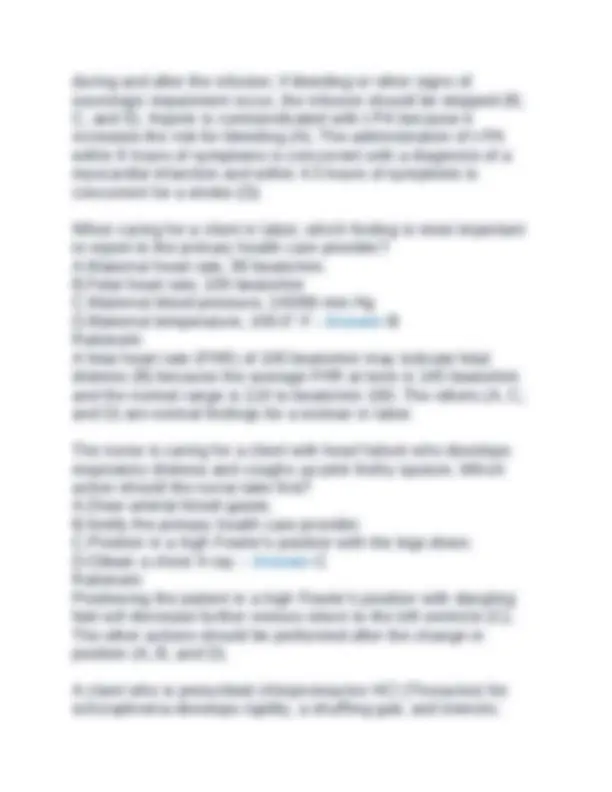
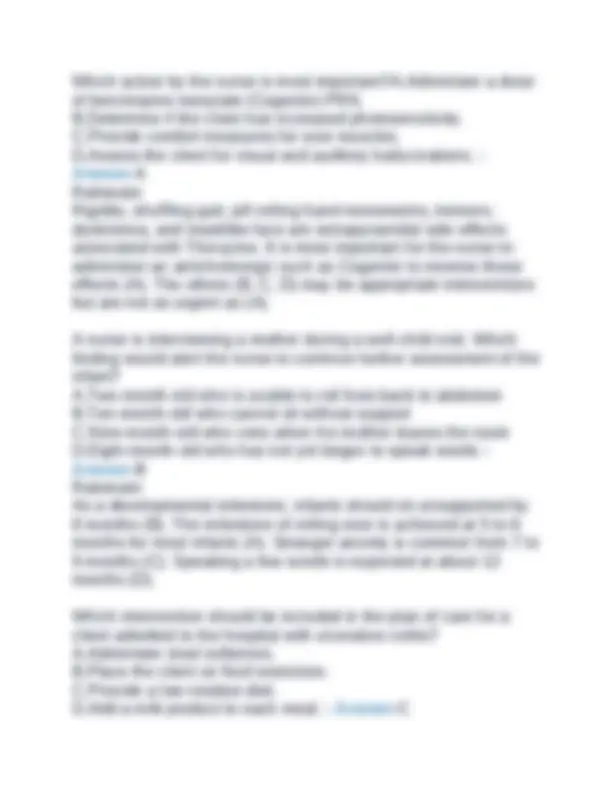
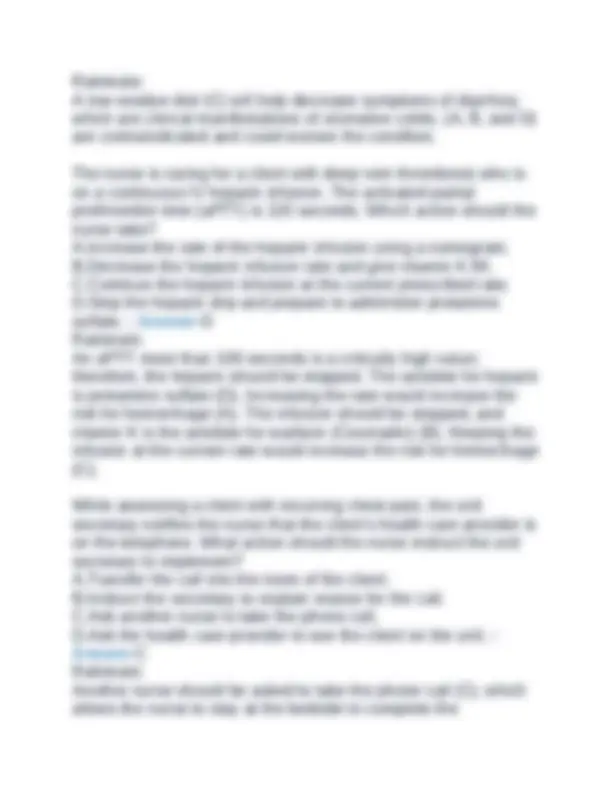
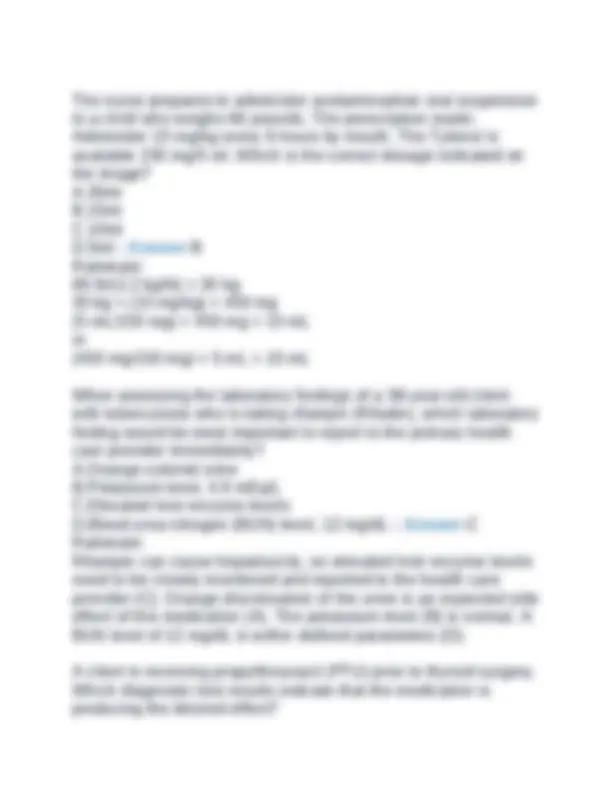
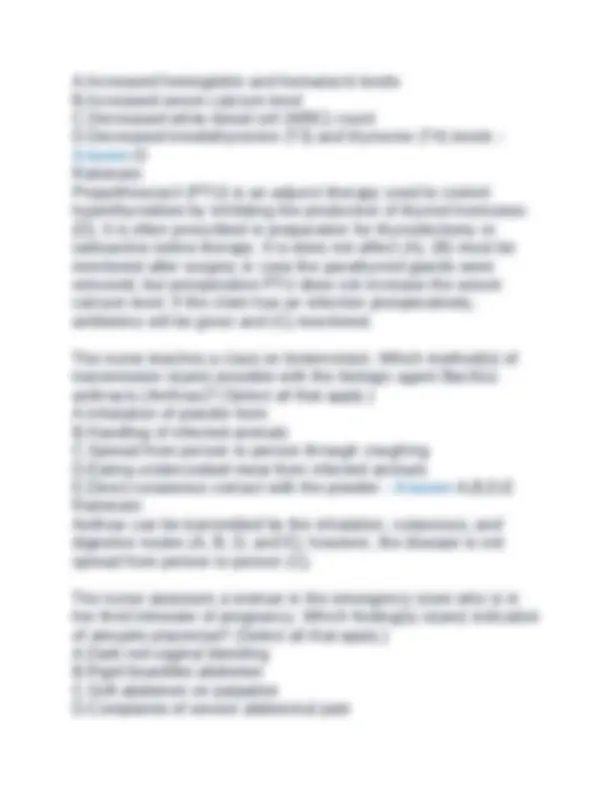
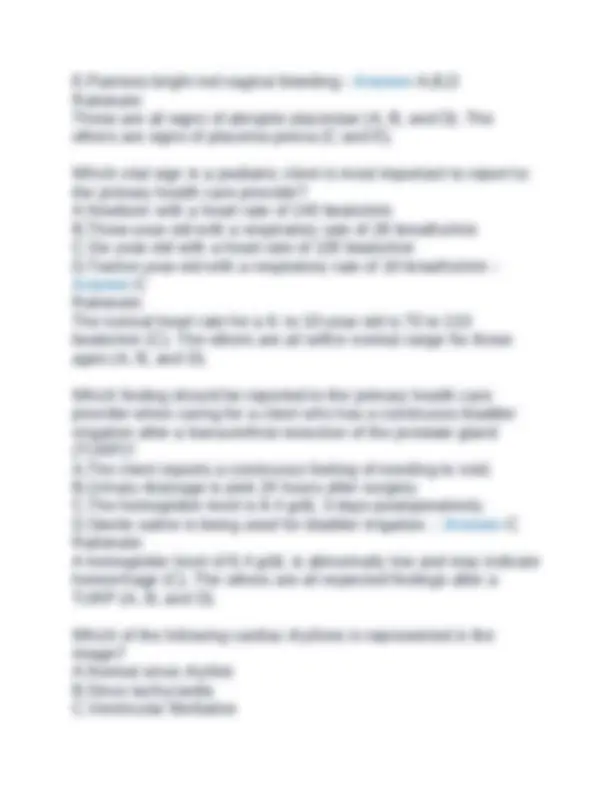
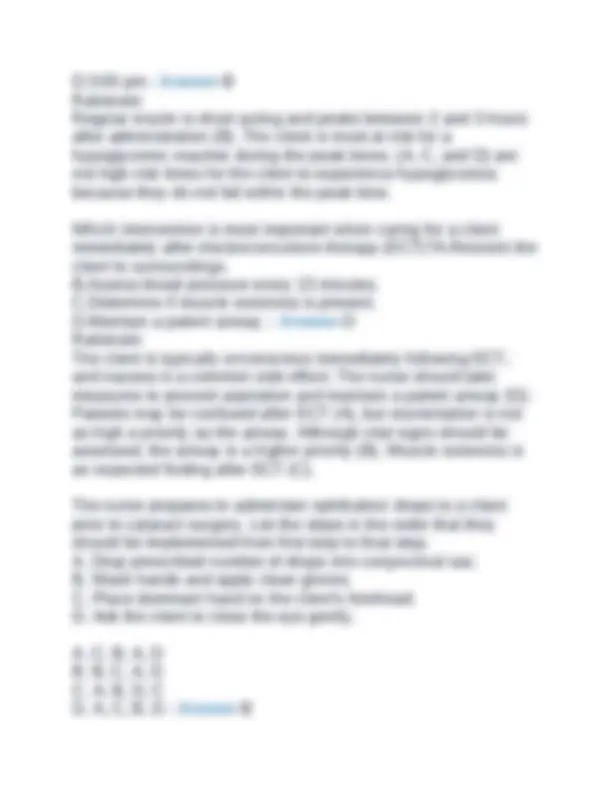
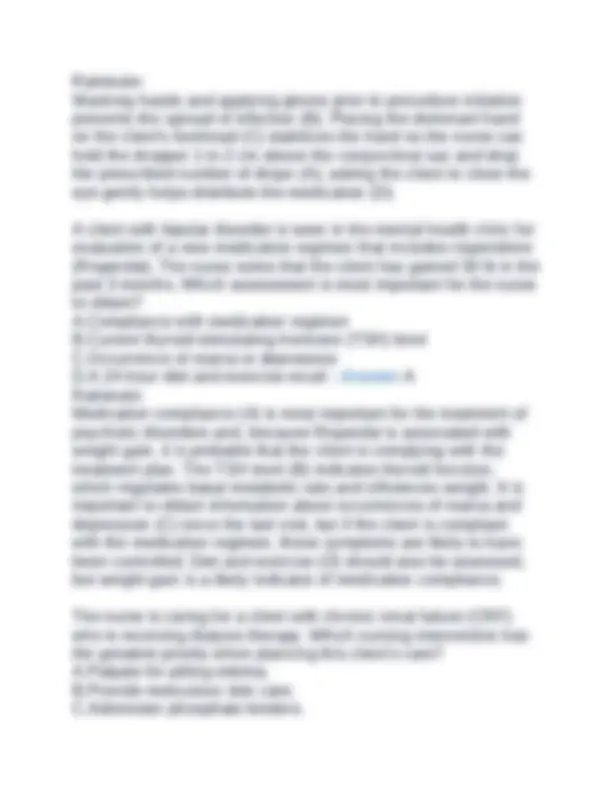
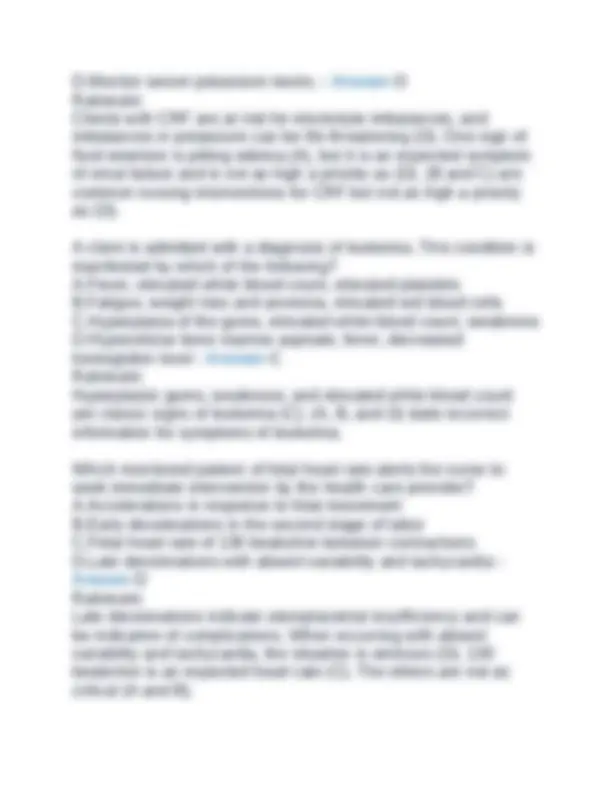
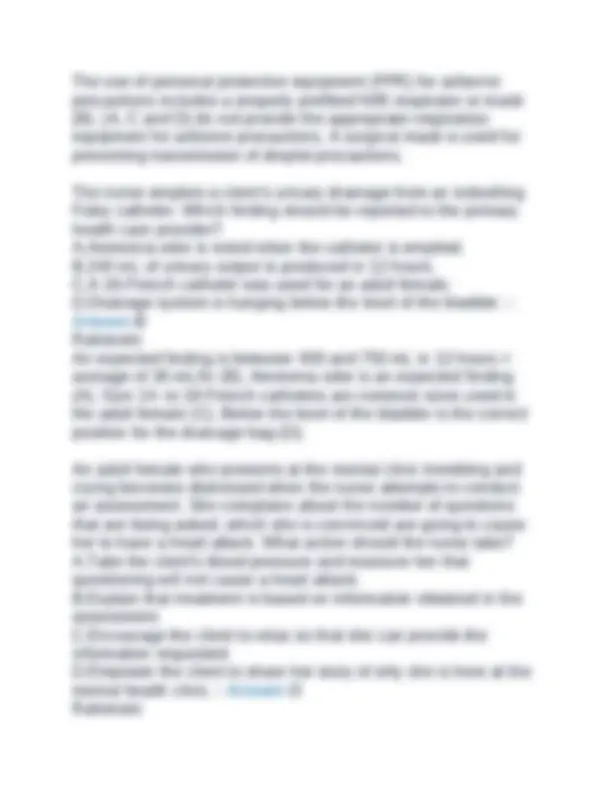
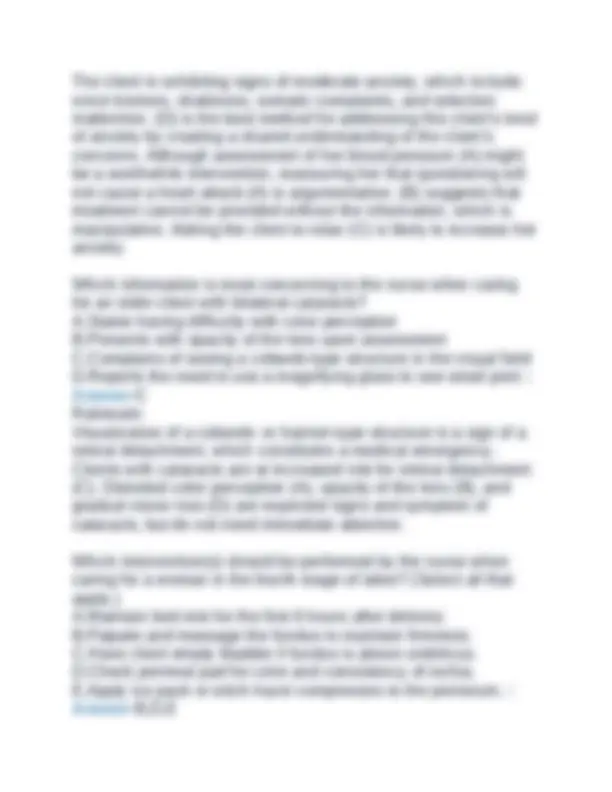
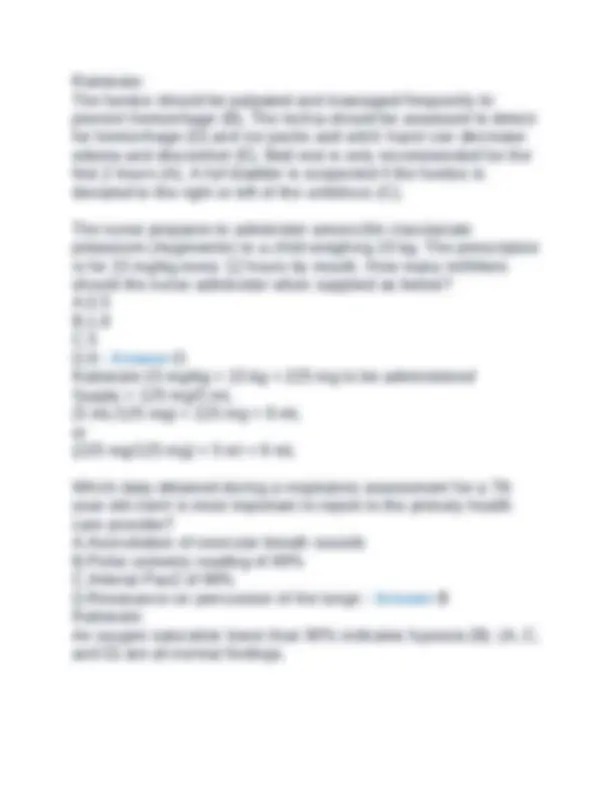
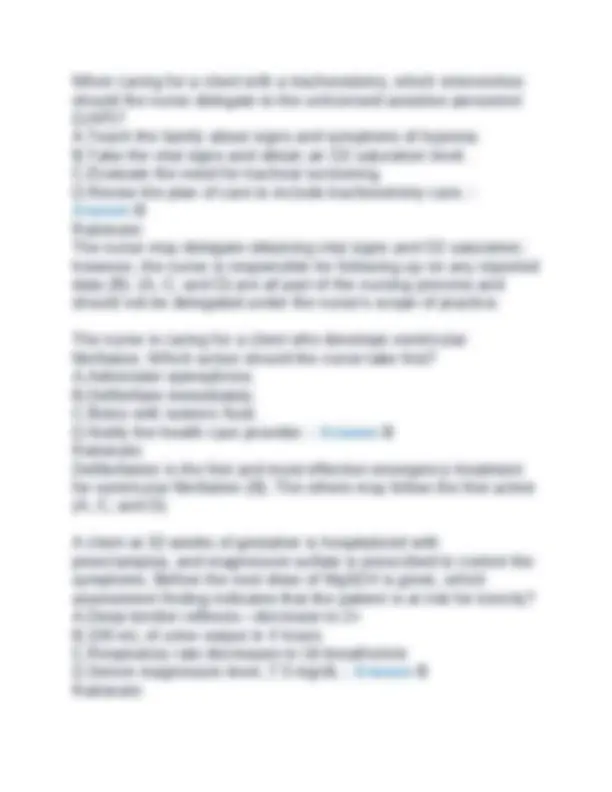
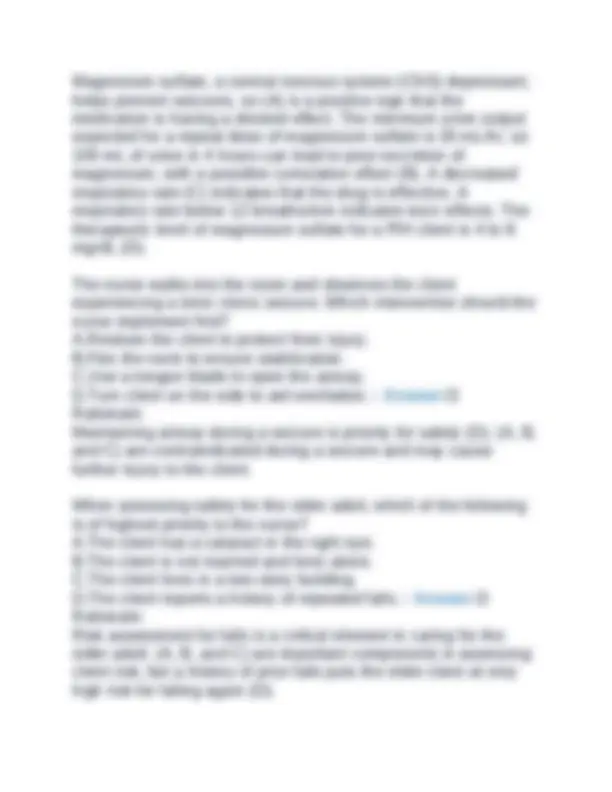
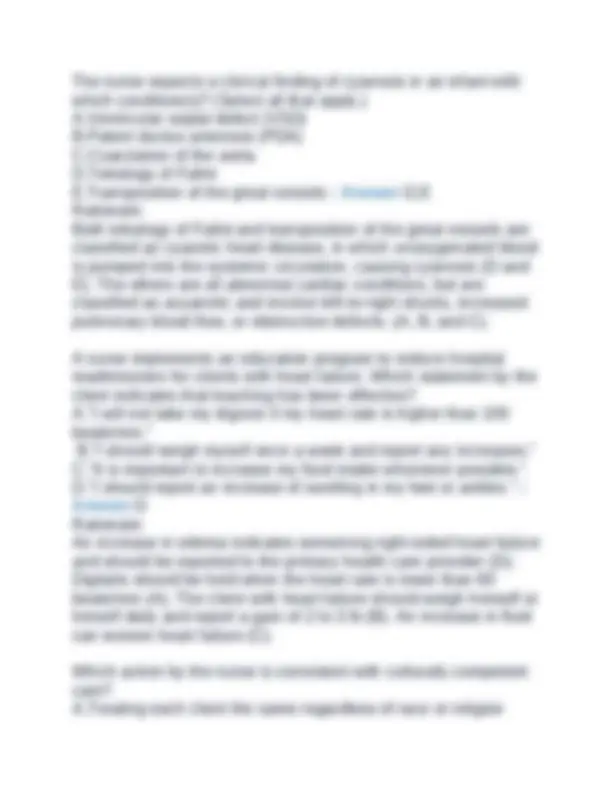
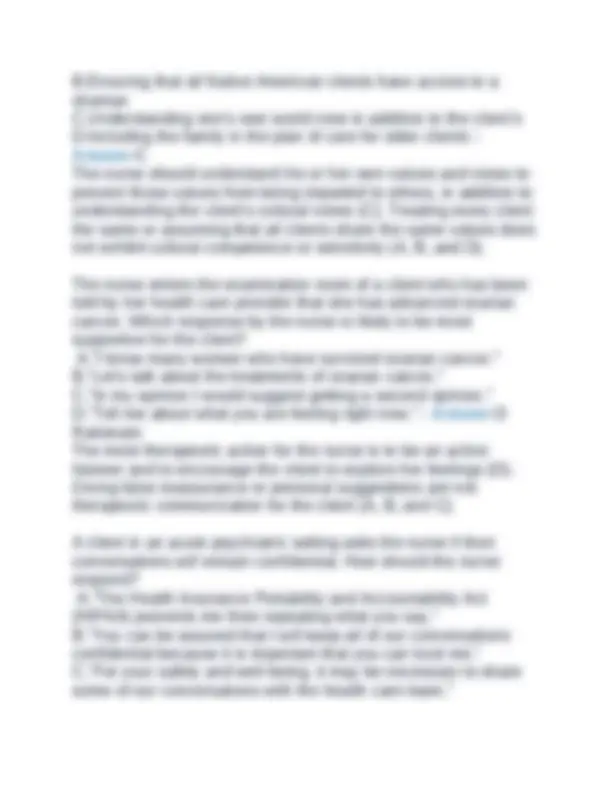
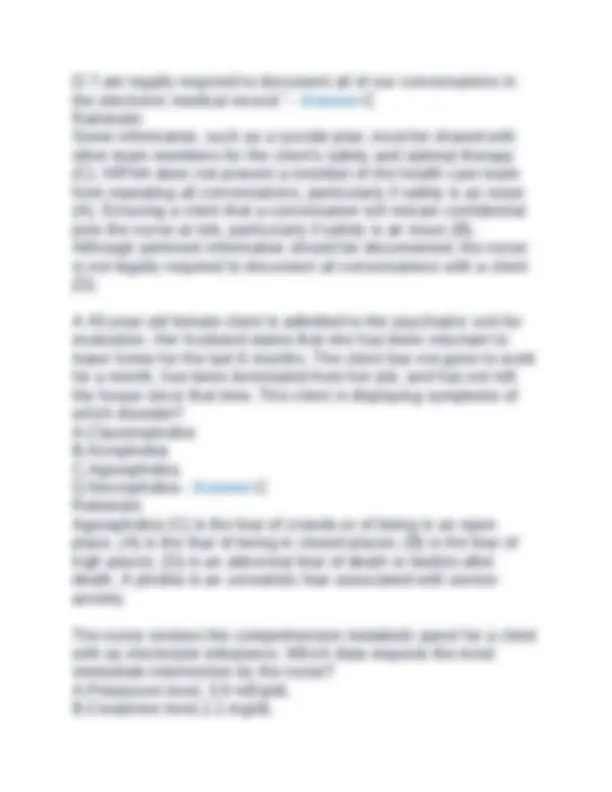
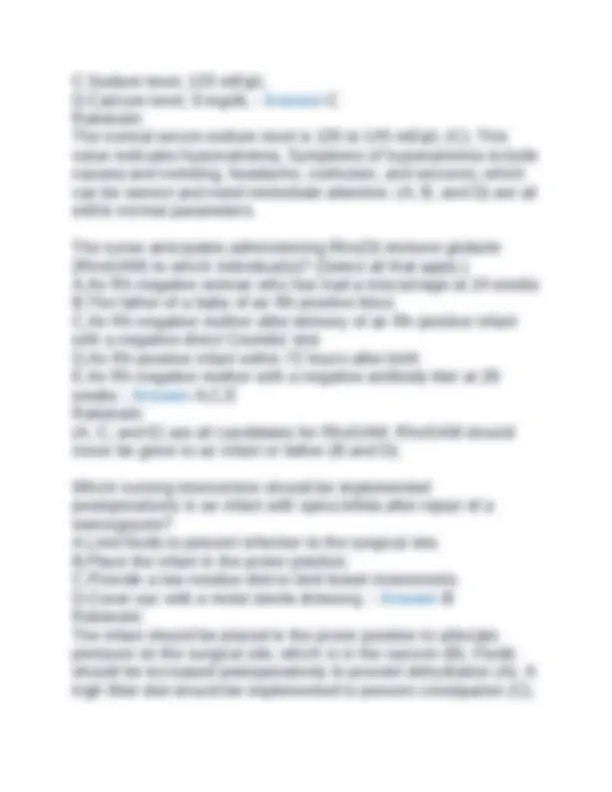
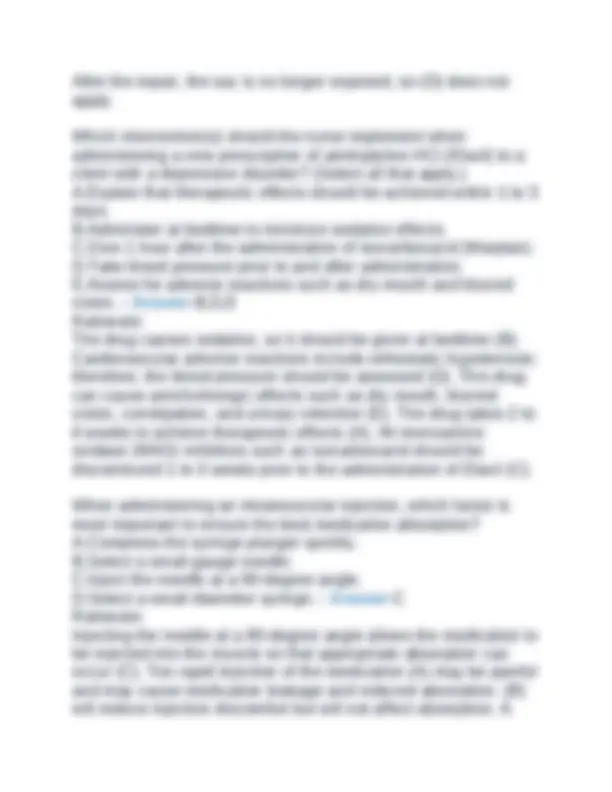
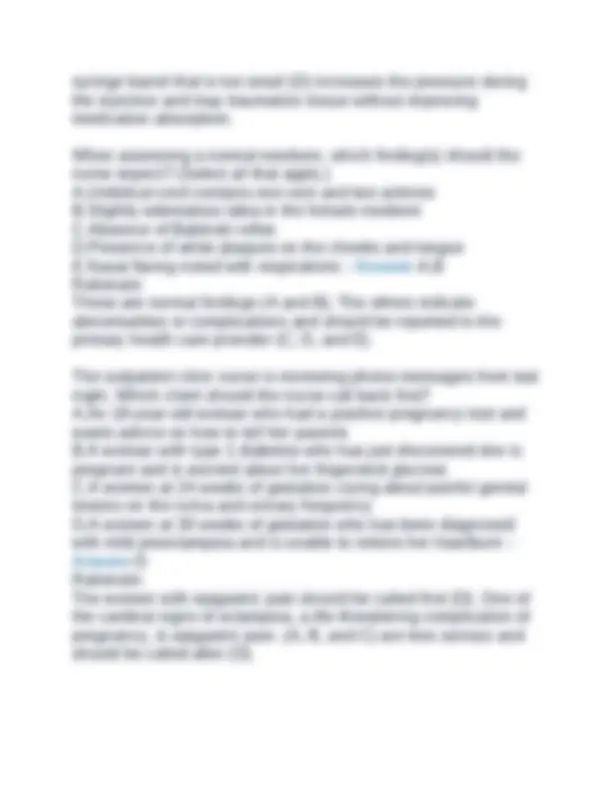
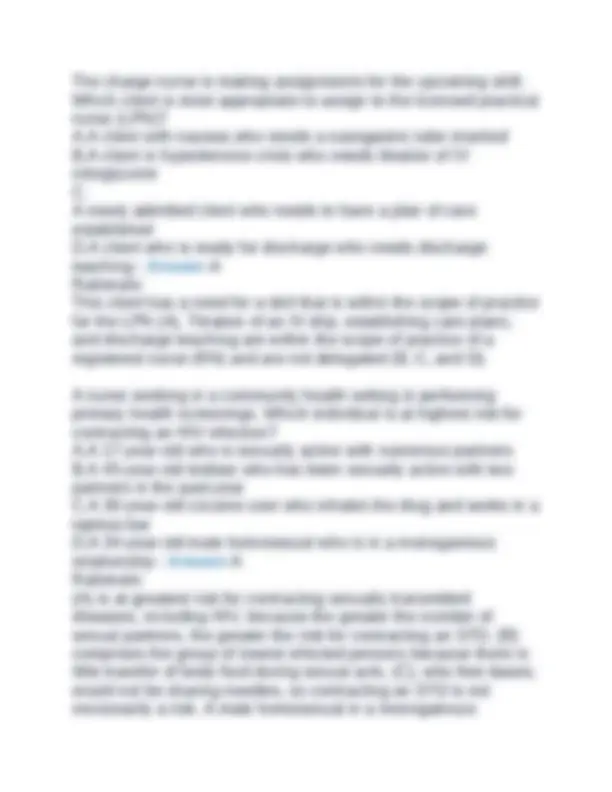
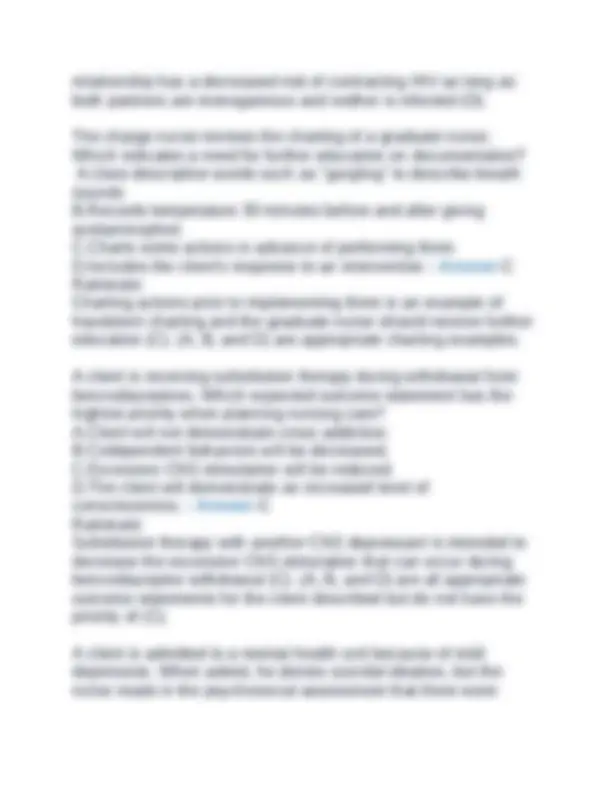
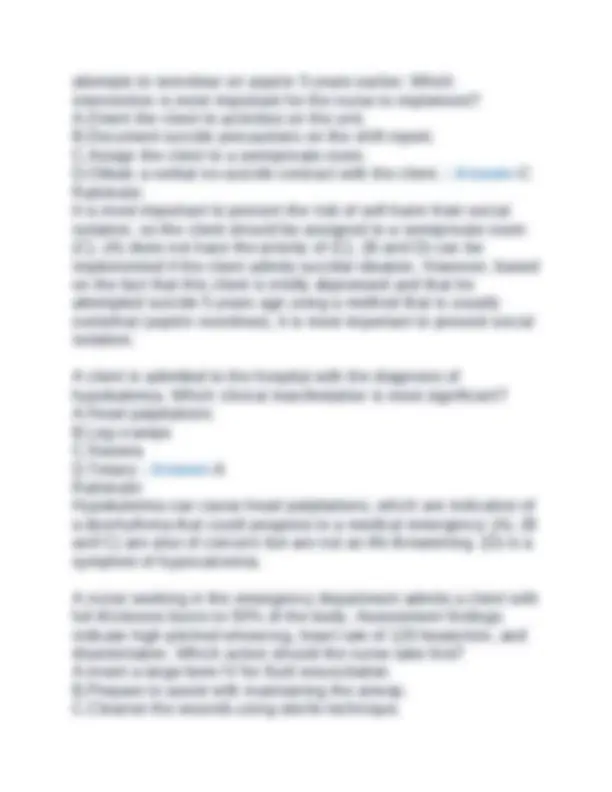
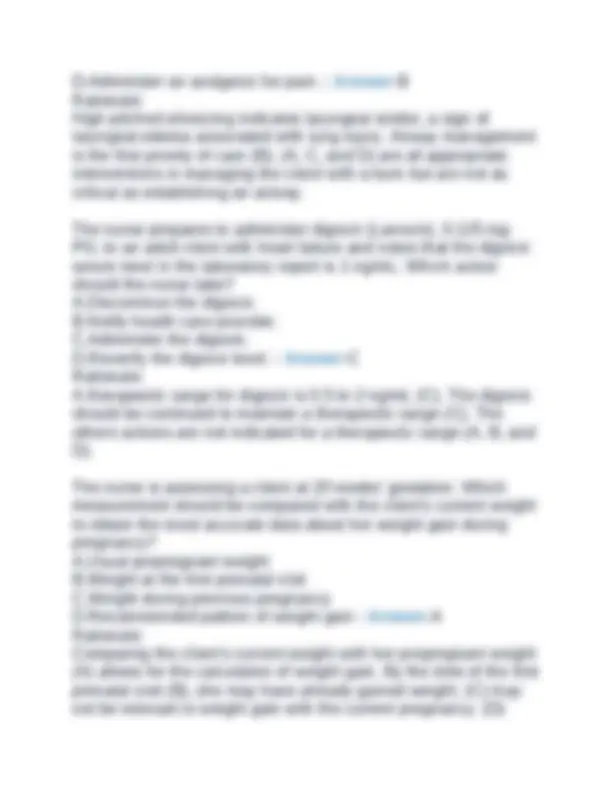
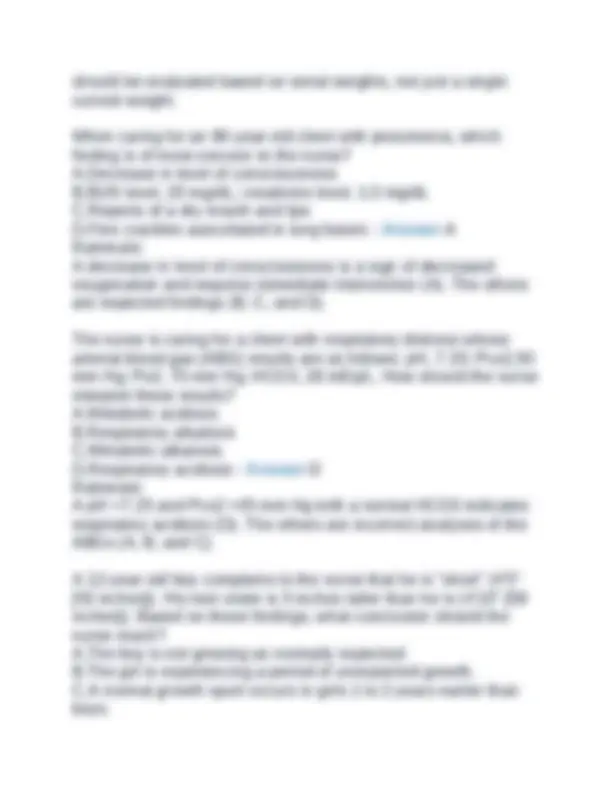
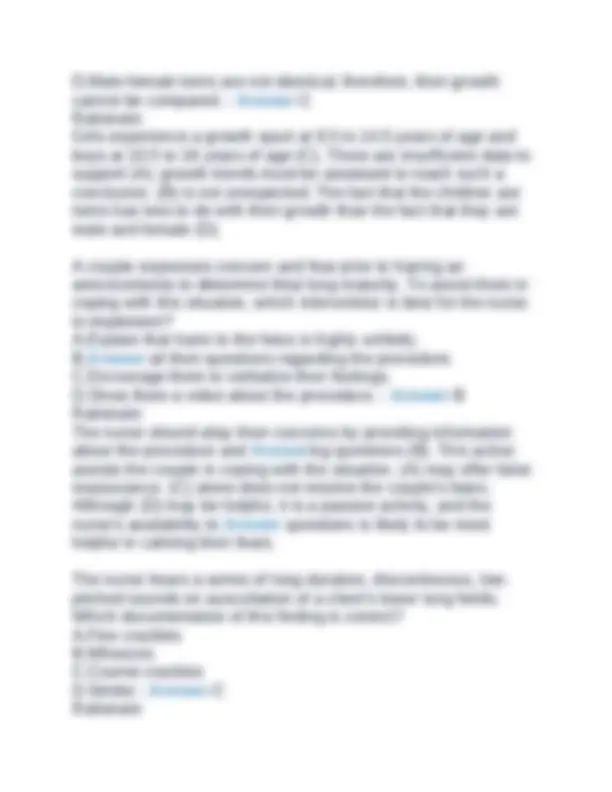
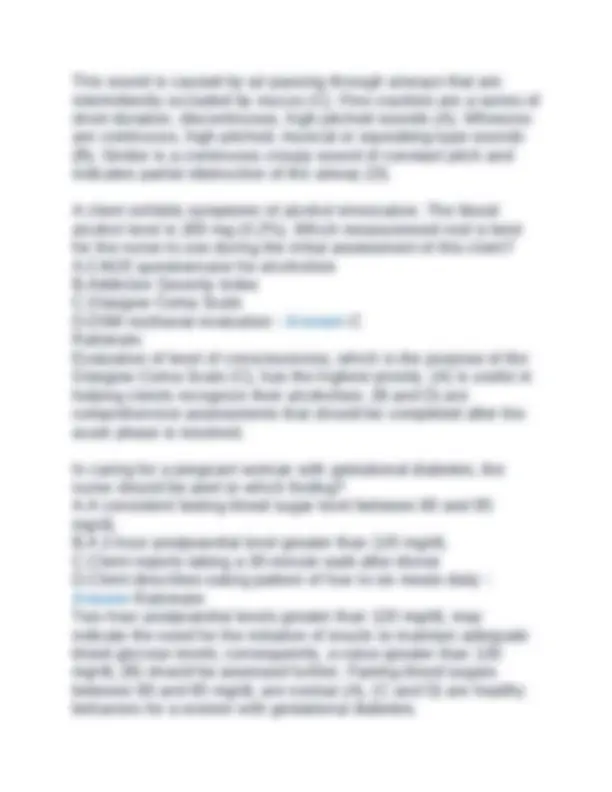
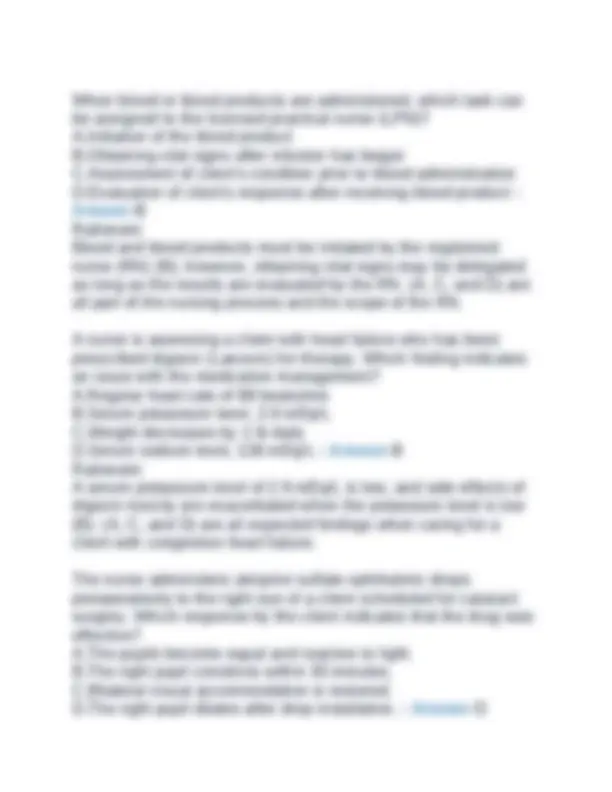
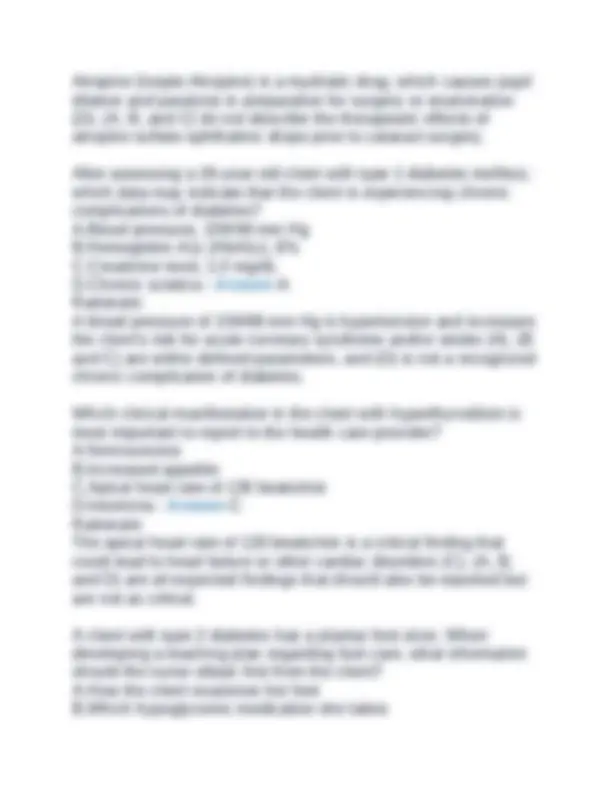
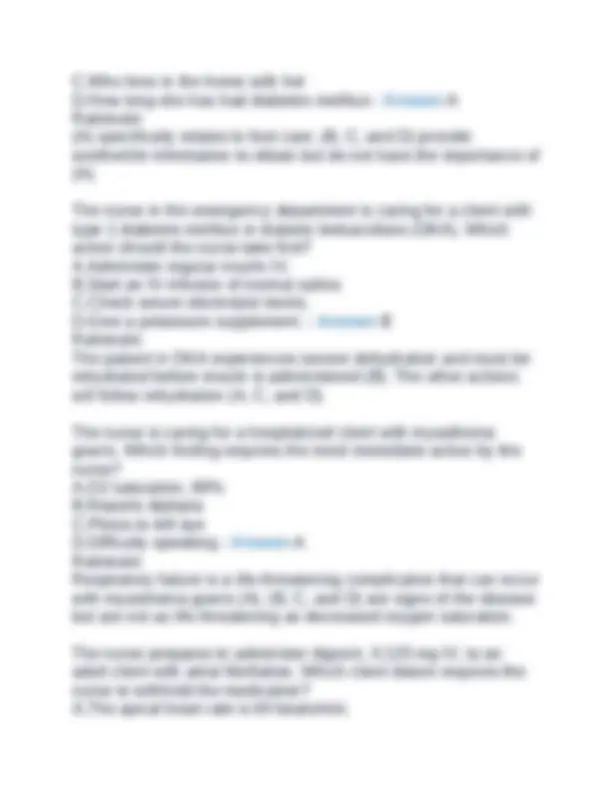
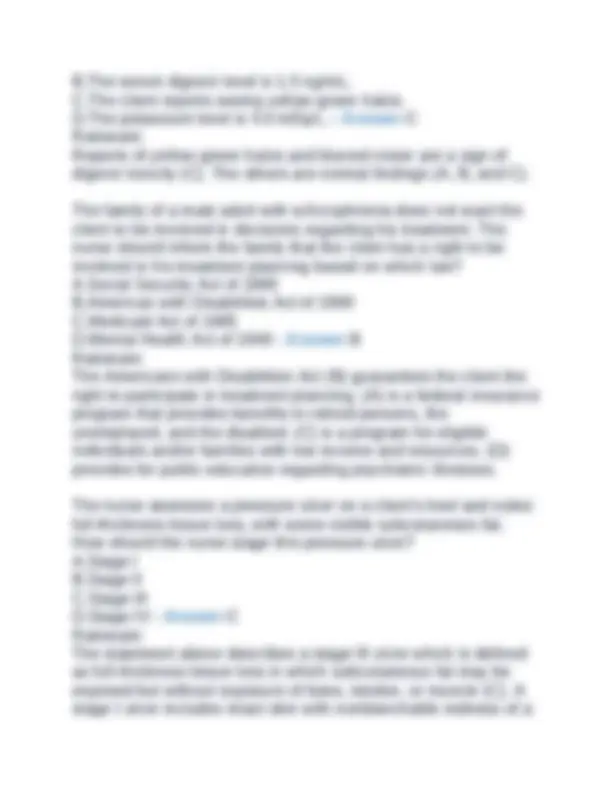
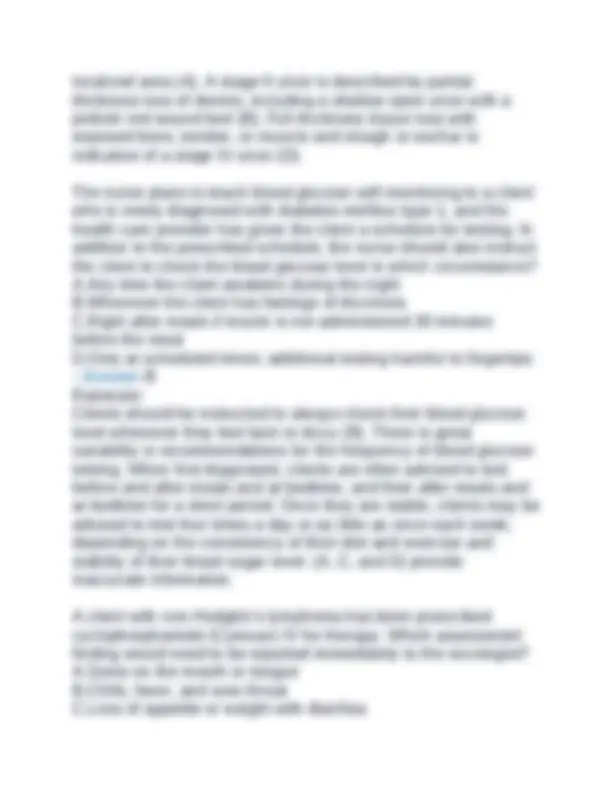
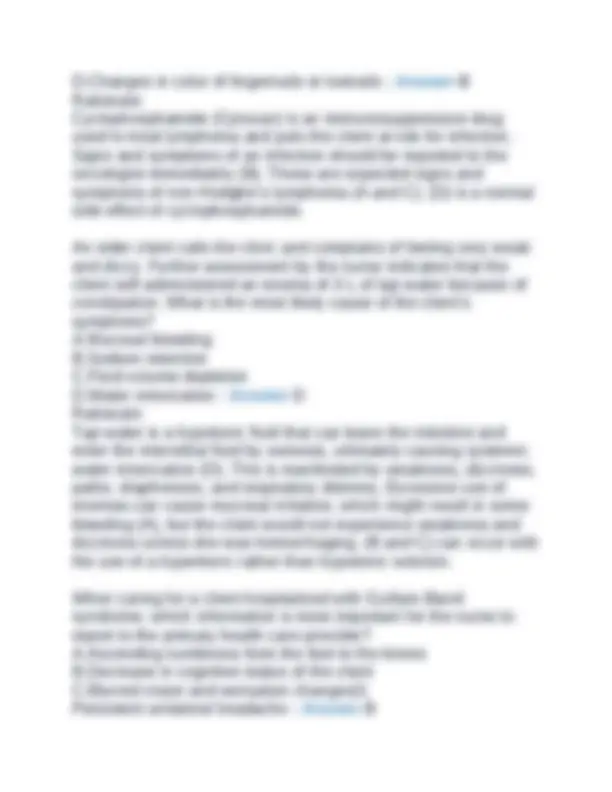
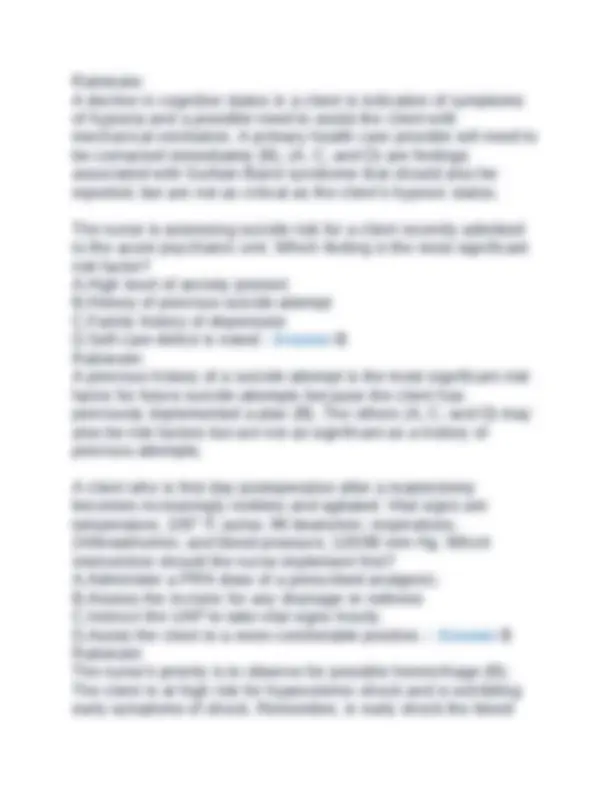
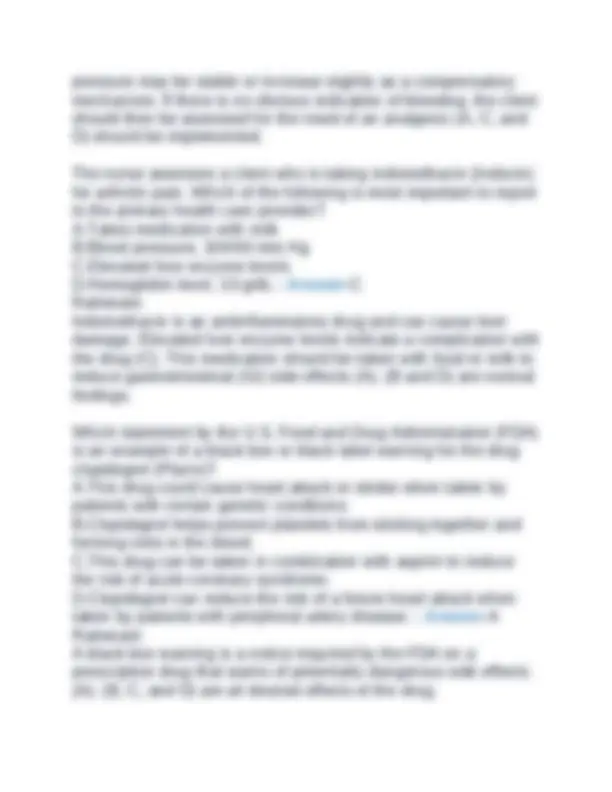
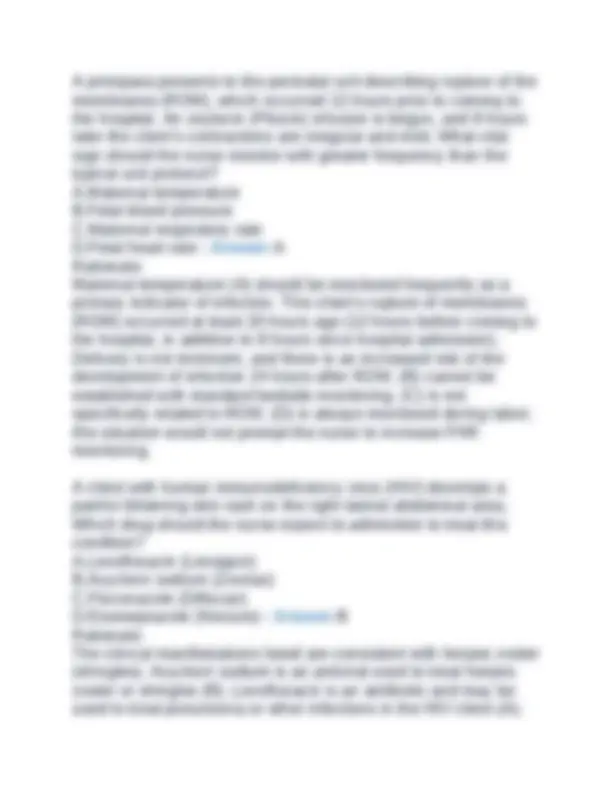
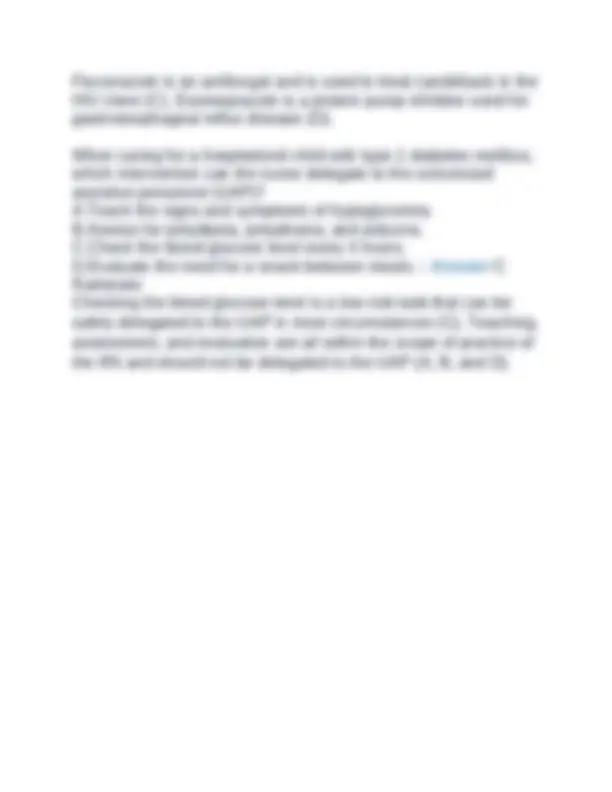


Study with the several resources on Docsity

Earn points by helping other students or get them with a premium plan


Prepare for your exams
Study with the several resources on Docsity

Earn points to download
Earn points by helping other students or get them with a premium plan
Community
Ask the community for help and clear up your study doubts
Discover the best universities in your country according to Docsity users
Free resources
Download our free guides on studying techniques, anxiety management strategies, and thesis advice from Docsity tutors
NGN NURSING HESI EXIT EXAM LATEST 2024 EXAM QUESTIONS WITH CORRECT ANSWERS WITH RATIONALES | GRADED A+. NGN NURSING HESI EXIT EXAM LATEST 2024 EXAM QUESTIONS WITH CORRECT ANSWERS WITH RATIONALES | GRADED A+.
Typology: Exams
1 / 45

This page cannot be seen from the preview
Don't miss anything!






































The nurse is caring for a client with a cerebrovascular accident (CVA) who is receiving enteral tube feedings. Which task performed by the UAP requires immediate intervention by the nurse? A.Suctions oral secretions from mouth B.Positions head of bed flat when changing sheets C.Takes temperature using the axillary method D.Keeps head of bed elevated at 30 degrees - Answer -B Rationale: Positioning the head of the bed flat when enteral feedings are in progress puts the client at risk for aspiration (B). The others are all acceptable tasks performed by the UAP (A, C, and D). When caring for a postsurgical client who has undergone multiple blood transfusions, which serum laboratory finding is of most concern to the nurse? A.Sodium level, 137 mEq/L B.Potassium level, 5.5 mEq/L C.Blood urea nitrogen (BUN) level, 18 mg/dL D.Calcium level, 10 mEq/L - Answer -B Rationale: Multiple blood transfusions are a risk factor for hyperkalemia. A serum potassium level higher than 5.0 mEq/L indicates hyperkalemia (B). The others are normal findings (A, C, and D). Which vaccination should the nurse administer to a newborn? A.Hepatitis B B.Human papilloma virus (HPV)
C.Varicella D.Meningococcal vaccine - Answer -A Rationale: The hepatitis B vaccination should be given to all newborns before hospital discharge (A). HPV is not recommended until adolescence (B). Varicella immunization begins at 12 months (C). Meningococcal vaccine is administered beginning at 2 years (D). The nurse is caring for a client on the medical unit. Which task can be delegated to unlicensed assistive personnel (UAP)? A.Assess the need to change a central line dressing. B.Obtain a fingerstick blood glucose level. C. Answer a family member's questions about the client's plan of care. D.Teach the client side effects to report related to the current medication regimen. - Answer -B Rationale: Obtaining a fingerstick blood glucose level is a simple treatment and is an appropriate skill for UAP to perform (B). (A, C, and D) are skills that cannot be delegated to UAP. The nurse is caring for a client with an ischemic stroke who has a prescription for tissue plasminogen activator (t-PA) IV. Which action(s) should the nurse expect to implement? (Select all that apply.) A.Administer aspirin with tissue plasminogen activator (t-PA). B.Complete the National Institute of Health Stroke Scale (NIHSS). C.Assess the client for signs of bleeding during and after the infusion. D.Start t-PA within 6 hours after the onset of stroke symptoms. E.Initiate multidisciplinary consult for potential rehabilitation. - Answer -B,C,E Rationale: Neurologic assessment, including the NIHSS, is indicated for the client receiving t-PA. This includes close monitoring for bleeding
Which action by the nurse is most important?A.Administer a dose of benztropine mesylate (Cogentin) PRN. B.Determine if the client has increased photosensitivity. C.Provide comfort measures for sore muscles. D.Assess the client for visual and auditory hallucinations. - Answer -A Rationale: Rigidity, shuffling gait, pill-rolling hand movements, tremors, dyskinesia, and masklike face are extrapyramidal side effects associated with Thorazine. It is most important for the nurse to administer an anticholinergic such as Cogentin to reverse these effects (A). The others (B, C, D) may be appropriate interventions but are not as urgent as (A). A nurse is interviewing a mother during a well-child visit. Which finding would alert the nurse to continue further assessment of the infant? A.Two-month-old who is unable to roll from back to abdomen B.Ten-month-old who cannot sit without support C.Nine-month-old who cries when his mother leaves the room D.Eight-month-old who has not yet begun to speak words - Answer -B Rationale: As a developmental milestone, infants should sit unsupported by 8 months (B). The milestone of rolling over is achieved at 5 to 6 months for most infants (A). Stranger anxiety is common from 7 to 9 months (C). Speaking a few words is expected at about 12 months (D). Which intervention should be included in the plan of care for a client admitted to the hospital with ulcerative colitis? A.Administer stool softeners. B.Place the client on fluid restriction. C.Provide a low-residue diet. D.Add a milk product to each meal. - Answer -C
Rationale: A low-residue diet (C) will help decrease symptoms of diarrhea, which are clinical manifestations of ulcerative colitis. (A, B, and D) are contraindicated and could worsen the condition. The nurse is caring for a client with deep vein thrombosis who is on a continuous IV heparin infusion. The activated partial prothrombin time (aPTT) is 120 seconds. Which action should the nurse take? A.Increase the rate of the heparin infusion using a nomogram. B.Decrease the heparin infusion rate and give vitamin K IM. C.Continue the heparin infusion at the current prescribed rate. D.Stop the heparin drip and prepare to administer protamine sulfate. - Answer -D Rationale: An aPTT more than 100 seconds is a critically high value; therefore, the heparin should be stopped. The antidote for heparin is protamine sulfate (D). Increasing the rate would increase the risk for hemorrhage (A). The infusion should be stopped, and vitamin K is the antidote for warfarin (Coumadin) (B). Keeping the infusion at the current rate would increase the risk for hemorrhage (C). While assessing a client with recurring chest pain, the unit secretary notifies the nurse that the client's health care provider is on the telephone. What action should the nurse instruct the unit secretary to implement? A.Transfer the call into the room of the client. B.Instruct the secretary to explain reason for the call. C.Ask another nurse to take the phone call. D.Ask the health care provider to see the client on the unit. - Answer -C Rationale: Another nurse should be asked to take the phone call (C), which allows the nurse to stay at the bedside to complete the
C.Avoid combining the two insulins because incompatibility could cause an adverse reaction. D.Administer the regular insulin subcutaneously and then give the NPH IV to prevent a separate stick. - Answer -B Rationale: The regular or "clear" insulin should be withdrawn into the syringe first, followed by the NPH (B). Air should first be injected into the NPH vial and then air should be inserted into the regular vial (A). NPH and regular insulin are compatible, and combining will reduce the number of injections (C). The insulin is ordered subcutaneously and NPH cannot be given IV (D). An 8-year-old child is receiving digoxin (Lanoxin) for congestive heart failure (CHF). In assessing the child, the nurse finds that her apical heart rate is 80 beats/min, she complains of being slightly nauseated, and her serum digoxin level is 1.2 ng/mL. What action should the nurse take? A.Because the child's heart rate and digoxin level are within normal range, assess for the cause of the nausea. B.Hold the next dose of digoxin until the health care provider can be notified because the serum digoxin level is elevated. C.Administer the next dose of digoxin and notify the health care provider that the child is showing signs of toxicity. D.Notify the health care provider that the child's pulse rate is below normal for her age group. - Answer -A Rationale: Nausea and vomiting are early signs of digoxin toxicity. However, the normal resting heart rate for a child 8 to 10 years of age is 70 to 110 beats/min and the therapeutic range of serum digoxin levels is 0.5 to 2 ng/mL. Based on the objective data, (A) is the best of the choices provided because the serum digoxin level is within normal levels. (B) is not warranted by the data presented. The digoxin level is within the therapeutic range and the child is not showing signs of toxicity (C). The child's pulse rate is within normal range for her age group (D).
The nurse prepares to administer acetaminophen oral suspension to a child who weighs 66 pounds. The prescription reads: Administer 15 mg/kg every 6 hours by mouth. The Tylenol is available 150 mg/5 ml. Which is the correct dosage indicated on the image? A.30ml B.15ml C.10ml D.5ml - Answer -B Rationale: 66 lb/(2.2 kg/lb) = 30 kg 30 kg × (15 mg/kg) = 450 mg (5 mL/150 mg) × 450 mg = 15 mL or (450 mg/150 mg) × 5 mL = 15 mL When assessing the laboratory findings of a 38-year-old client with tuberculosis who is taking rifampin (Rifadin), which laboratory finding would be most important to report to the primary health care provider immediately? A.Orange-colored urine B.Potassium level, 4.9 mEq/L C.Elevated liver enzyme levels D.Blood urea nitrogen (BUN) level, 12 mg/dL - Answer -C Rationale: Rifampin can cause hepatoxicity, so elevated liver enzyme levels need to be closely monitored and reported to the health care provider (C). Orange discoloration of the urine is an expected side effect of this medication (A). The potassium level (B) is normal. A BUN level of 12 mg/dL is within defined parameters (D). A client is receiving propylthiouracil (PTU) prior to thyroid surgery. Which diagnostic test results indicate that the medication is producing the desired effect?
E.Painless bright red vaginal bleeding - Answer -A,B,D Rationale: These are all signs of abruptio placentae (A, B, and D). The others are signs of placenta previa (C and E). Which vital sign in a pediatric client is most important to report to the primary health care provider? A.Newborn with a heart rate of 140 beats/min B.Three-year-old with a respiratory rate of 28 breaths/min C.Six-year-old with a heart rate of 130 beats/min D.Twelve-year-old with a respiratory rate of 16 breaths/min - Answer -C Rationale: The normal heart rate for a 6- to 10-year-old is 70 to 110 beats/min (C). The others are all within normal range for those ages (A, B, and D). Which finding should be reported to the primary health care provider when caring for a client who has a continuous bladder irrigation after a transurethral resection of the prostate gland (TURP)? A.The client reports a continuous feeling of needing to void. B.Urinary drainage is pink 24 hours after surgery. C.The hemoglobin level is 8.4 g/dL 3 days postoperatively. D.Sterile saline is being used for bladder irrigation. - Answer -C Rationale: A hemoglobin level of 8.4 g/dL is abnormally low and may indicate hemorrhage (C). The others are all expected findings after a TURP (A, B, and D). Which of the following cardiac rhythms is represented in the image? A.Normal sinus rhythm B.Sinus tachycardia C.Ventricular fibrillation
D.Atrial fibrillation - Answer -C Rationale: Ventricular fibrillation (C) is a life-threatening arrhythmia characterized by irregular undulations of varying amplitudes. (A, B, and D) are not represented in the image. An adult client with a medical diagnosis of substance abuse and schizophrenia was recently switched from oral fluphenazine HCl (Prolixin) to IM fluphenazine decanoate (Prolixin Decanoate) because of medication noncompliance. What should the nurse teach the client and family about this change in medication regimen? A.Long-acting medication is more effective than daily medication. B.A client with substance abuse must not take any oral medications. C.There will continue to be a risk of alcohol and drug interaction. D.Support groups are only helpful for substance abuse treatment.
D.3:00 pm - Answer -B Rationale: Regular insulin is short-acting and peaks between 2 and 3 hours after administration (B). The client is most at risk for a hypoglycemic reaction during the peak times. (A, C, and D) are not high-risk times for the client to experience hypoglycemia because they do not fall within the peak time. Which intervention is most important when caring for a client immediately after electroconvulsive therapy (ECT)?A.Reorient the client to surroundings. B.Assess blood pressure every 15 minutes. C.Determine if muscle soreness is present. D.Maintain a patent airway. - Answer -D Rationale: The client is typically unconscious immediately following ECT, and nausea is a common side effect. The nurse should take measures to prevent aspiration and maintain a patent airway (D). Patients may be confused after ECT (A), but reorientation is not as high a priority as the airway. Although vital signs should be assessed, the airway is a higher priority (B). Muscle soreness is an expected finding after ECT (C). The nurse prepares to administer ophthalmic drops to a client prior to cataract surgery. List the steps in the order that they should be implemented from first step to final step. A. Drop prescribed number of drops into conjunctival sac. B. Wash hands and apply clean gloves. C. Place dominant hand on the client's forehead. D. Ask the client to close the eye gently. A. C, B, A, D B. B, C, A, D C. A, B, D, C D. A, C, B, D - Answer -B
Rationale: Washing hands and applying gloves prior to procedure initiation prevents the spread of infection (B). Placing the dominant hand on the client's forehead (C) stabilizes the hand so the nurse can hold the dropper 1 to 2 cm above the conjunctival sac and drop the prescribed number of drops (A); asking the client to close the eye gently helps distribute the medication (D). A client with bipolar disorder is seen in the mental health clinic for evaluation of a new medication regimen that includes risperidone (Risperdal). The nurse notes that the client has gained 30 lb in the past 3 months. Which assessment is most important for the nurse to obtain? A.Compliance with medication regimen B.Current thyroid-stimulating hormone (TSH) level C.Occurrence of mania or depression D.A 24-hour diet and exercise recall - Answer -A Rationale: Medication compliance (A) is most important for the treatment of psychotic disorders and, because Risperdal is associated with weight gain, it is probable that the client is complying with the treatment plan. The TSH level (B) indicates thyroid function, which regulates basal metabolic rate and influences weight. It is important to obtain information about occurrences of mania and depression (C) since the last visit, but if the client is compliant with the medication regimen, these symptoms are likely to have been controlled. Diet and exercise (D) should also be assessed, but weight gain is a likely indicator of medication compliance. The nurse is caring for a client with chronic renal failure (CRF) who is receiving dialysis therapy. Which nursing intervention has the greatest priority when planning this client's care? A.Palpate for pitting edema. B.Provide meticulous skin care. C.Administer phosphate binders.
Which disaster management intervention by the nurse is an example of primary prevention? A.Emergency department triage B.Follow-up care for psychological problems C.Education of rescue workers in first aid D.Treatment of clients who are injured - Answer -C Rationale: Primary prevention is aimed at preventing disease or injury. Training rescue workers prior to a disaster is an example of minimizing or preventing injury (C). (A) is an example of secondary prevention. (B) is an example of tertiary prevention. (D) is an example of secondary prevention. The nurse is caring for a client who is experiencing severe pain. The expected outcome the nurse writes for the client reads, "The client will state my pain is less than 2 within 45 minutes after pain medication has been administered." Formulating the expected outcome is an example of which step in the nursing process? A.Assessment B.Planning C.Implementation D.Evaluation - Answer -B Rationale: Planning (B) allows the nurse to set goals for care and elicit the expected outcome by identifying appropriate nursing actions. Assessment, implementation, and evaluation are part of the care for the client but are not the appropriate actions for formulating the expected outcome (A, C, and D). The nurse is planning the care for a client who is admitted with syndrome of inappropriate antidiuretic hormone secretion (SIADH). Which intervention(s) should the nurse include in this client's plan of care? (Select all that apply.) A.Salt-free diet B.Quiet environment
C.Deep tendon reflex assessments D.Neurologic checks E.Daily weights - Answer -B,C,D,E Rationale: Correct responses are (B, C, D, and E). SAIDH results in water retention and dilutional hyponatremia, which causes neurologic changes when serum sodium levels are less than 115 mEq/L. The nurse should maintain a quiet environment (B) to prevent overstimulation and assess deep tendon reflexes (C) and perform neurologic checks (D) to monitor for neurologic deterioration. Daily weights (E) should be monitored to assess for fluid overload. (A) would contribute to dilutional hyponatremia. A client in the psychiatric setting with an anxiety disorder reports chest pain. Which action should the nurse take first? A.Administer an antianxiety medication PRN. B.Assess the client's vital signs. C.Notify the primary health care provider. D.Determine coping mechanisms used in the past. - Answer -B Rationale: Although increased heart rate, palpitations, and chest pain may be caused by anxiety, it is important that the nurse assess the patient and rule out physiologic causes (B). Nonpharmacologic measures should be taken first (A). (C and D) may be considered but are not as high priority as the initial physiologic assessment. The charge nurse observes a student nurse enter the room of a client who is prescribed airborne precautions. The application of which personal protective equipment by the student indicates a correct understanding of this precaution? A.Surgical mask, clean gloves, and gown B.Properly fitted N95 respirator or mask C.Sterile gloves and gown D.Goggles, clean gloves, and gown - Answer -B Rationale:
The client is exhibiting signs of moderate anxiety, which include voice tremors, shakiness, somatic complaints, and selective inattention. (D) is the best method for addressing this client's level of anxiety by creating a shared understanding of the client's concerns. Although assessment of her blood pressure (A) might be a worthwhile intervention, reassuring her that questioning will not cause a heart attack (A) is argumentative. (B) suggests that treatment cannot be provided without the information, which is manipulative. Asking the client to relax (C) is likely to increase her anxiety. Which information is most concerning to the nurse when caring for an older client with bilateral cataracts? A.States having difficulty with color perception B.Presents with opacity of the lens upon assessment C.Complains of seeing a cobweb-type structure in the visual field D.Reports the need to use a magnifying glass to see small print - Answer -C Rationale: Visualization of a cobweb- or hairnet-type structure is a sign of a retinal detachment, which constitutes a medical emergency. Clients with cataracts are at increased risk for retinal detachment (C). Distorted color perception (A), opacity of the lens (B), and gradual vision loss (D) are expected signs and symptom of cataracts, but do not need immediate attention. Which intervention(s) should be performed by the nurse when caring for a woman in the fourth stage of labor? (Select all that apply.) A.Maintain bed rest for the first 6 hours after delivery. B.Palpate and massage the fundus to maintain firmness. C.Have client empty bladder if fundus is above umbilicus. D.Check perineal pad for color and consistency of lochia. E.Apply ice pack or witch hazel compresses to the perineum. - Answer -B,D,E
Rationale: The fundus should be palpated and massaged frequently to prevent hemorrhage (B). The lochia should be assessed to detect for hemorrhage (D) and ice packs and witch hazel can decrease edema and discomfort (E). Bed rest is only recommended for the first 2 hours (A). A full bladder is suspected if the fundus is deviated to the right or left of the umbilicus (C). The nurse prepares to administer amoxicillin clavulanate potassium (Augmentin) to a child weighing 15 kg. The prescription is for 15 mg/kg every 12 hours by mouth. How many milliliters should the nurse administer when supplied as below? A.0. B.1. C. D.9 - Answer -D Rationale:15 mg/kg × 15 kg = 225 mg to be administered Supply = 125 mg/5 mL (5 mL/125 mg) × 225 mg = 9 mL or (225 mg/125 mg) × 5 ml = 9 mL Which data obtained during a respiratory assessment for a 78- year-old client is most important to report to the primary health care provider? A.Auscultation of vesicular breath sounds B.Pulse oximetry reading of 89% C.Arterial Pao2 of 86% D.Resonance on percussion of the lungs - Answer -B Rationale: An oxygen saturation lower than 90% indicates hypoxia (B). (A, C, and D) are all normal findings.